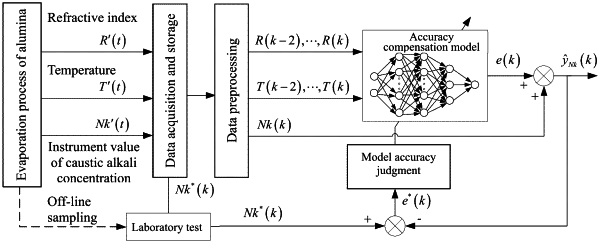| CPC G06N 3/044 (2023.01) [G01N 33/00 (2013.01); G06F 17/17 (2013.01)] | 5 Claims |

|
1. A method for compensating an accuracy of a discharge caustic alkali concentration measuring device, wherein the device is used monitoring an alkali liquor in an evaporation process, comprising the following steps:
step 1. measuring the alkali liquor during the evaporation process to obtain process data comprising a refractive index, a temperature, an instrument value of alkalinity measured real-time using an on-line instrument, and a laboratory value of alkalinity measured off-line in a laboratory;
step 2. performing sliding average filtering, time series matching and normalization on the process data collected in step 1 to obtain preprocessed process data;
step 3. constructing an accuracy compensation model and inputting the preprocessed process data into the accuracy compensation model of the caustic alkali concentration measuring device to obtain a compensation value; and
step 4 adding the compensation value of the caustic alkali concentration to the instrument value to realize the on-line compensation of the caustic alkali concentration,
wherein constructing the accuracy compensation model comprises training a double-layer Long Short-Term Memory (LSTM) network using historical refractive index data and historical temperature data as input training data and errors between historical instrument values and historical laboratory values as output training data.
|